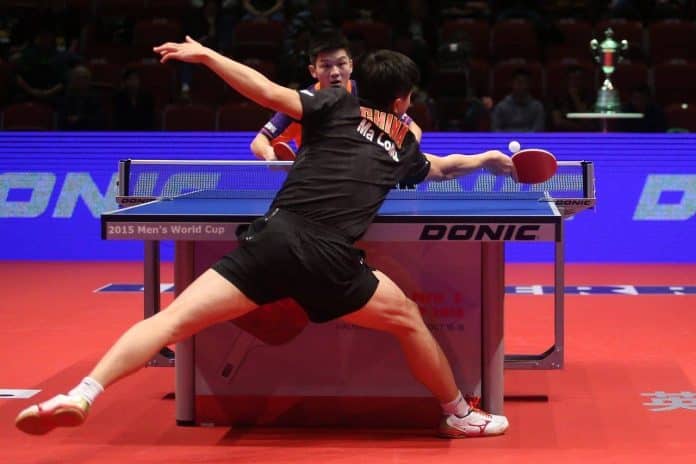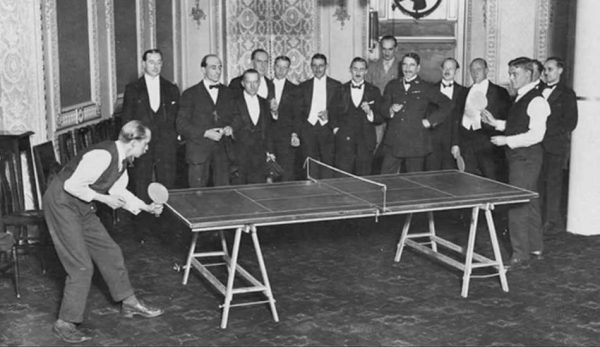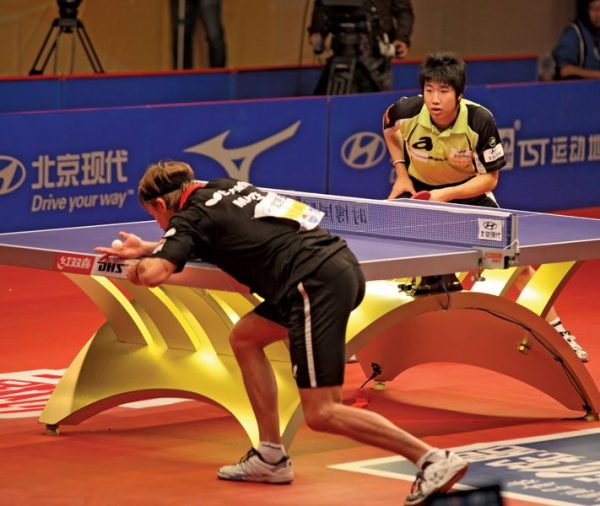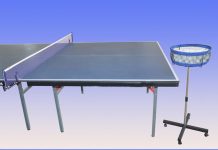Ladies and gentlemen, brace yourselves for a fascinating journey into the origins of one of the most beloved sports in the world – ping-pong!
In this article, we will uncover the fascinating history behind the peculiar name of this game that has captured the hearts of millions.
So, grab your paddles and prepare to be enlightened as we dive into the enchanting tale of how ping-pong got its name.
This image is the property of www.99sportz.com.
Review contents
History of Table Tennis
Origin
The history of table tennis can be traced back to the late 19th century. The game was initially played as an indoor version of tennis, using makeshift equipment and adapting the rules to fit the limited space. It quickly gained popularity among upper-class English society as a leisure activity.
Evolution of the Game
As the game gained traction, it underwent several transformations to become the table tennis we know today. These changes were driven by a desire to make the game more accessible and exciting. The early players experimented with different equipment and rules to enhance the gameplay and create a unique experience.
Early Names
Before table tennis became officially known as “table tennis,” it went by various names in its early years. These names were often playful and reflected the lighthearted nature of the game. Some early monikers included “whiff-whaff” and “gossima,” which added to the whimsical and friendly atmosphere surrounding the sport.
Adoption of Ping-pong
The term “ping-pong” emerged as one of the famous names for the sport. However, its adoption and global usage were not without challenges. A trademark dispute in the early 1900s changed the name to “table tennis” to avoid legal complications. Despite the change, “ping-pong” continued to be widely recognized and used informally by many enthusiasts.
Origin of Ping-pong
Invention by British Army Officers
The invention of ping-pong can be credited to British Army officers stationed in India during the late 19th century. Seeking a game to keep themselves entertained, they improvised a version of tennis that could be played indoors on a table. This early version of the game involved using books as rackets and a champagne cork or a rubber ball as the ball.
Early Equipment and Rules
As the game gained popularity, the equipment used became more specialized. The books were replaced with wooden paddles, and the ball was changed to celluloid. The rules also underwent refinement to create a more structured and competitive experience. These early developments laid the foundation for the modern game of table tennis.
Rise in Popularity
Ping-pong quickly spread beyond the confines of the British Army officers’ circles and gained popularity among the general public. The accessible nature of the game, with its simple rules and minimal equipment requirements, allowed people of all ages and backgrounds to enjoy it. Ping-pong became an everyday recreational activity in schools, clubs, and homes, further fueling its popularity.
This image is a property of qph.cf2.quoracdn.net.
Evolution of the Game
From Indoor Tennis to Table Tennis
The transformation of ping-pong into table tennis involved a change in name and significant modifications to the game itself. The focus shifted from imitating outdoor tennis to creating a distinct and enjoyable table-based sport. The smaller playing area and faster pace of the game demanded quick reflexes, agility, and precision, leading to the development of unique playing techniques.
Standardization of Equipment
To ensure fairness and consistency in the game, a process of standardization for equipment was initiated. Specifications for paddles, balls, and tables were established to create a level playing field for all participants. This standardization allowed players to focus on their skills and strategies, knowing that their equipment met the approved standards.
International Table Tennis Federation (ITTF)
The International Table Tennis Federation (ITTF) was formed in 1926 to govern and promote the sport globally. The ITTF plays a vital role in setting and updating the rules of table tennis, organizing international competitions, and overseeing the development of the sport at all levels. Their efforts have helped elevate table tennis to a recognized and respected sport worldwide.
Early Names for Table Tennis
Whiff-whaff
One of the earliest names for table tennis was “whiff-whaff.” This playful name captured the sound of the ball bouncing back and forth on the table. It added an element of fun and excitement to the game, emphasizing the fast-paced nature of the sport.
Gossima
“Gossima” was another name used to refer to table tennis in its early years. The origin of this name is unclear, but it contributed to the evolving lexicon of the sport. The whimsical and distinctive name further emphasized the friendly and approachable nature of the game.
Ping-pong
Perhaps the most famous name associated with table tennis, “ping-pong,” originated from the sound of the ball bouncing on the wooden table surface. The name resonated with players and became synonymous with the sport itself. Despite later adopting the official name “table tennis,” “ping-pong” continued to be widely used, especially in informal and recreational settings.
This image is the property of www.aspirantsg.com.
The Adoption of Ping-pong
Trademark Dispute
During the early 1900s, a trademark dispute arose over “ping-pong.” This legal conflict prompted the need for a new name for the sport. The dispute centered around the name’s ownership and its potential commercial use. To avoid further complications, the decision was made to adopt the name “table tennis,” which became the official designation for the sport.
Official Name Change
Although “table tennis” became the official name, “ping-pong” remained deeply ingrained in the public consciousness. People continued to use the name informally, recognizing it as a synonymous term for the sport. While the official name change was necessary to resolve the trademark dispute, the popularity and recognition of “ping-pong” continued to persist.
Global Usage
The popularity of ping-pong and its widespread usage expanded beyond its British origins. As the game evolved and gained international recognition, so did the term “ping-pong.” It became a universally recognizable name for the sport irrespective of the official designation. Ping-pong became a common reference point, transcending linguistic and cultural barriers in many countries.
The Meaning Behind Ping-pong
Onomatopoeic Sound
The name “ping-pong” owes its creation to the onomatopoeic sound produced by the ball hitting the table and bouncing back. The distinct “ping” and “pong” sounds came to represent the essence of the game, encapsulating its dynamic and energetic nature. The name resonated with players and fans, creating an auditory connection to the sport.
Influence of Chinese Language
The Chinese language might have also influenced the adoption of “ping-pong” as a name. The word “ping” means “flat” or “level” in Chinese, reflecting the nature of the playing surface. Additionally, the Chinese used ” ping-pong ” to describe their version of the sport, further solidifying the global association of the name with table tennis.
Simplicity and Catchiness
One of the reasons why “ping-pong” became the favored name for the sport is its simplicity and catchiness. The short, repetitive syllables are easy to pronounce and remember, making them highly accessible to people of all ages and language backgrounds. The name’s simplicity contributes to the game’s overall friendly and approachable image.
This image is the property of cdn.britannica.com.
Ping-pong vs. Table Tennis
Distinctive Characteristics
While “ping-pong” and “table tennis” are often used interchangeably, there are subtle differences between the two terms. “Ping-pong” is commonly associated with the recreational aspect of the sport, emphasizing a casual and relaxed atmosphere. On the other hand, “table tennis” tends to represent the more competitive and organized aspects of the game, including professional tournaments and international competitions.
Ping-pong as a Recreational Game
Ping-pong, with its inherent simplicity and accessibility, has become a popular recreational game worldwide. It is often enjoyed in schools, community centers, and homes, providing a friendly and enjoyable activity for people of all skill levels. Ping-pong’s inclusive and entertaining nature continues to attract enthusiasts around the globe.
Professional Table Tennis
As the official name for the sport, table tennis encompasses the professional aspects of the game. It denotes the highly competitive nature of international tournaments, where skilled athletes showcase their abilities. Professional table tennis requires intense training, strategic thinking, and exceptional physical agility, making it a demanding and thrilling sport at the highest level.
Promotion and Global Recognition
Olympic Inclusion
The inclusion of table tennis in the Olympic Games has significantly promoted the sport globally. Since its debut in the Olympics in 1988, table tennis has captured the attention of millions worldwide, exposing the sport to new audiences and inspiring aspiring players. Olympic recognition has elevated table tennis to a prestigious level, increasing its visibility and appeal.
Celebrity Endorsements
Several high-profile celebrities and public figures have publicly endorsed and played table tennis, contributing to its global recognition. From politicians to actors, the sport has attracted the attention of individuals who recognize its entertainment value and physical benefits. These endorsements have further enhanced the image of table tennis as a fun and engaging activity.
Ping-pong Diplomacy
Ping-pong has played an unexpected role in international diplomacy. In 1971, a series of friendly matches between American and Chinese players named “ping-pong diplomacy” helped thaw diplomatic tensions between the two nations. This unique use of the sport as a diplomatic tool brought the global spotlight to table tennis and emphasized its capacity to bridge cultural and political divides.
This image is the property of i.ytimg.com.
Ping-pong Around the World
Ping-pong in Asia
Asia, particularly China, has been a powerhouse in table tennis. The sport is popular in countries like China, Japan, and South Korea, with dedicated training programs and a solid professional circuit. The success of Asian players in international competitions has elevated the region’s status as a dominant force in the world of table tennis.
Ping-pong in Europe
Europe has a rich history and tradition in table tennis. Numerous European countries boast highly competitive leagues and world-class players. The European Table Tennis Union (ETTU) oversees the region’s table tennis development, organizing events and nurturing young talent. European players have consistently performed well on the world stage, contributing to the sport’s global appeal.
Ping-pong in North America
While table tennis is less widespread in North America than in Asia or Europe, it still has a dedicated following. The United States has produced some notable table tennis players, and the sport continues to be enjoyed at both recreational and competitive levels. Organizations like USA Table Tennis work towards promoting and developing the sport within the country.
Ping-pong in Popular Culture
Movies and TV Shows
Ping-pong has made numerous appearances in movies and TV shows, often showcasing its fun and entertaining aspects. Films like “Balls of Fury” and “Ping Pong Playa” have brought table tennis to the big screen, incorporating humor, drama, and thrilling matches. Similarly, TV shows such as “Friends” and “The Simpsons” have featured memorable ping-pong moments, further embedding the sport within popular culture.
Ping-pong Tournaments
Ping-pong tournaments, both at amateur and professional levels, have become a staple in the world of sports. These events attract players of all ages and skill levels, offering an opportunity to compete and socialize within the table tennis community. From local club tournaments to major international championships, the excitement and camaraderie found in ping-pong tournaments contribute to the sport’s enduring popularity.
Ping-pong in Music
The lively and rhythmic nature of ping-pong has also influenced the music world. The iconic sounds of the ball bouncing and the paddles striking the ball have been sampled and incorporated into various musical compositions. Ping-pong has inspired musicians using its energetic spirit to create catchy and innovative tunes.
In conclusion, the history of table tennis is a fascinating journey that has led to the global recognition and popularity of the sport. From its humble beginnings as an improvised game to becoming an Olympic sport, table tennis or ping-pong has captured the hearts of enthusiasts worldwide.
Its accessibility, competitive edge, and friendly atmosphere make table tennis a beloved activity that people of all ages and backgrounds enjoy.




























![Best Outdoor Dartboards [Reviews and Buying Guide 2024] Best Outdoor Dartboards](https://gamersets.com/wp-content/uploads/2022/12/Best-Outdoor-Dartboards-100x70.jpg)

![Best Mini Air Hockey Table [Reviews & Buying Guide 2024] Best mini air hockey table](https://gamersets.com/wp-content/uploads/2022/10/Best-mini-air-hockey-table-100x70.jpg)







